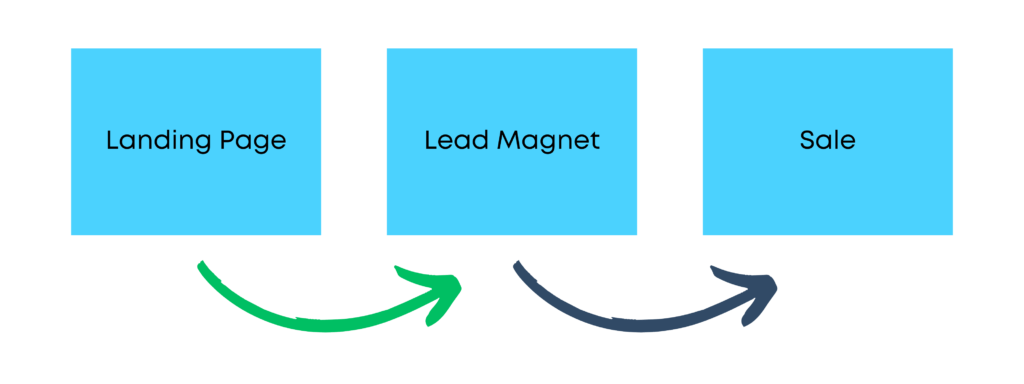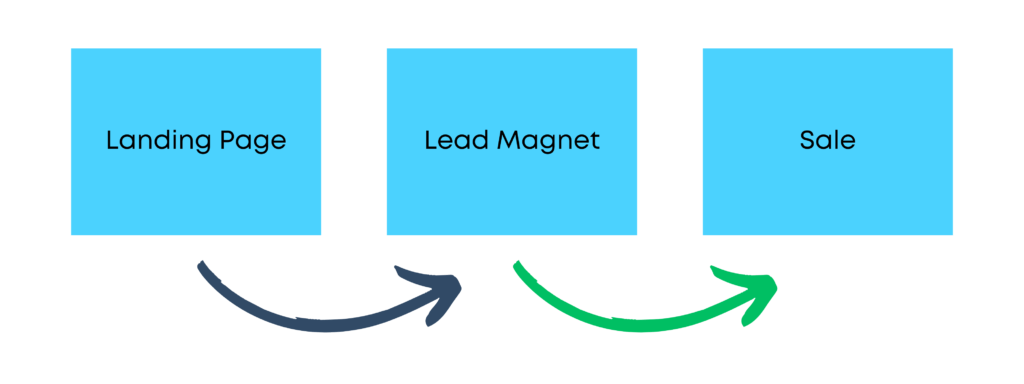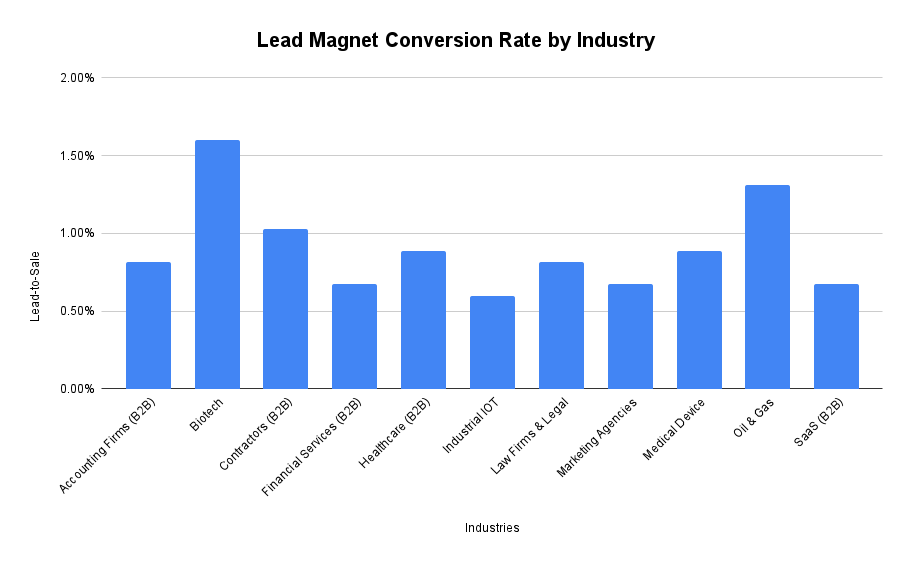Last Updated: July 2024
Lead magnets provide complete solutions for narrow problems to prospects of a business. Proper lead magnets highlight expertise and build trust without removing the need for a prospect to purchase a product or service from a business.
This article displays expectations for conversion rates for lead magnets within several industries.
- Channel-to-Lead measures the expected conversion rate for traffic from various sources
- Lead-to-Sale expresses the average percentage of leads who download the lead magnets that may turn into sales
- Best practices for improving channel-to-lead and lead-to-sale conversion rates
Channel-to-Lead Average Conversion Rate

In the table, you will find our expected landing page visit to lead magnet opt-in conversion rate for traffic driven from several sources.
Industries Email-to-Lead Linkedin-to-Lead Meta Ad-to-Lead Google Ads-to-Lead SEO-to-Lead
Accounting Firms (B2B) 8.66% 5.05% 4.05% 5.55% 4.07%
Biotech 12.00% 8.00% 7.00% 8.50% 8.00%
Contractors (B2B) 9.57% 5.86% 4.86% 6.36% 5.14%
Financial Services (B2B) 8.05% 4.52% 3.52% 5.02% 3.36%
Healthcare (B2B) 8.96% 5.32% 4.32% 5.82% 4.43%
Industrial IOT 7.75% 4.25% 3.25% 4.75% 3.00%
Law Firms & Legal Services (B2B) 8.66% 5.05% 4.05% 5.55% 4.07%
Marketing Agencies 8.05% 4.52% 3.52% 5.02% 3.36%
Medical Device 8.96% 5.32% 4.32% 5.82% 4.43%
Oil & Gas 10.79% 6.93% 5.93% 7.43% 6.57%
SaaS (B2B) 8.05% 4.52% 3.52% 5.02% 3.36%
April 2024 Update: We have updated Google Ads, LinkedIn, and Meta Ads to reflect a slightly lower channel-to-lead conversion rate due to increased spending on ad platforms in Q1 of 2024. Increased spending leads to ad platforms saturating the market with new offers and lead magnets, leading to slightly higher levels of market saturation with slightly lower channel-to-lead conversion rates.
July 2024 Update: Prices have continued to rise for digital advertising, a result of higher demand for advertising impressions. Now, more than ever, the advertising message must be clear and valuable to attract qualified leads. We have seen channel-to-lead conversion rates dip slightly, with lead-to-sale rates steady.
Lead-to-Sale Benchmarks

Below, you will see conversion rate benchmarks by industry for the percentage of people who downloaded your lead magnet who turn into sales.
Industries Lead-to-Sale
Accounting Firms (B2B) 0.81%
Biotech 1.60%
Contractors (B2B) 1.03%
Financial Services (B2B) 0.67%
Healthcare (B2B) 0.89%
Industrial IOT 0.60%
Law Firms & Legal Services (B2B) 0.81%
Marketing Agencies 0.67%
Medical Device 0.89%
Oil & Gas 1.31%
SaaS (B2B) 0.67%
April 2024 Update: Across industries, we have seen an increase in lead-to-sale conversion rates. As the US economy begins to move out of recession, we expect lead-to-sale conversion rates to increase further as companies again have extra cash to invest.
Best Practices for Improving Conversion Rates
If your lead magnet is not meeting the KPIs we’ve published above, consider some of the following ways to improve conversion rates.
Improving Channel-to-Lead (Landing Page) Conversion Rate
If your landing page conversion rate falls lower than the included KPIs above, consider some or all of the following suggestions.
Experiment with Different Offers
A lead magnet should be a complete solution to a narrow problem. Businesses make money by solving a string of problems for a customer that they cannot or do not want to solve themself.
In our experience, the lead magnet works best when it solves the first problem for a prospect, leading the prospect seamlessly into working with your company on a paid basis. Try testing different problems to offer solutions to via a lead magnet to improve the conversion rate.
Split Test Headlines
Once a proven offer is established, the headline of the landing page is the most critical factor in determining the conversion rate of the page. Headlines should instill curiosity in the viewer and convey confidence that the lead magnet will solve the problem they are facing.
Update the Form Submission
Ensure the information you are asking for represents a reasonable level of commitment for the prospect. If your page requires 5-10 pieces of information to access the lead magnet, consider just asking for an email or phone number to find out if asking for too much information is causing a low conversion rate.
Improving Lead-to-Sale (Lead Magnet) Conversion Rate
If you are experiencing visitors downloading your lead magnet, but not converting into customers at a reasonably high rate, consider the following ideas.
Improve the Quality
Typically, a low conversion rate is a symptom of a low-quality lead magnet. Ensure that the lead magnet is a complete solution to one specific, defined problem. People instinctively notice if the content is useful or simply fluff in an attempt to sell them a product.
Change the Delivery
Another possibility is the means of delivery does not work for the prospect. Ensure the content is easily digestible for the market. For example, if the lead magnet is an ebook, an audiobook could be created to ensure the content will be digested by more prospects.
Implement Follow Up Systems
Following up with leads to check for satisfaction with the lead magnet, answer questions, and invite them the take the next step with your company will improve the conversion rate. Try building follow-up systems comprised of email sequences, SMS sequences, and periodic phone calls.
To request a copy of this report, drop us a line on our Contact Us page.
